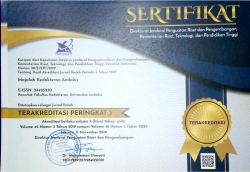DILEMA DALAM MANAJEMEN RETINOBLASTOMA
Abstract
Abstrak:
Retinoblastoma merupakan keganasan intraokular tersering pada anak-anak. Deteksi dini memegang peranan penting dalam manajemen retinoblastoma karena sangat mempengaruhi prognosa. Namun, hal ini sulit dilakukan di negara berkembang dengan tingkat sosioekonomi penduduk yang rendah. Penelitian ini bertujuan untuk menggambarkan profil retinoblastoma di RS Dr. M. Djamil Padang tahun 2003-2012, dan menunjukkan hubungan antara faktor sosioekonomi dengan manajemen retinoblastoma. Data diperoleh dari rekam medis pasien. Terdapat 99 pasien retinoblastoma dalam periode tersebut, 56 orang (56,56%) laki-laki dan 43 orang (43,44%) perempuan.Rentang umur terbanyak yaitu 3-4 tahun (40,40%). Retinoblastoma unilateral terdapat pada 76 pasien (76,76 %). Protusio merupakan keluhan tersering sebanyak 65,66% (65 orang). Kombinasi eksenterasi dan kemoterapi merupakan tindakan yang umum dilakukan (32,32%). Alasan terbanyak datang terlambat untuk berobat disebabkan oleh karena tidak punya biaya (42,42%) dan tidak mengerti mengenai bahaya penyakitnya (35,35%). Kedua faktor tersebut menjadi dilemma, oleh karena di satu sisi kita berusaha mendeteksi dini penyakit retinoblastoma ini, sementara dari segi finansial dan faktor sosioekonomi keluarga penderita tidak mendukung.
Abstract:
Retinoblastoma is the most common intraocular malignancy in children. Early detection plays an important role in management of retinoblastoma because it significantly affects the prognosis. Unfortunately, early detection is difficult in developing country due tolow socioeconomic level. This study aims to describe the profile of retinoblastoma in Dr. M. Djamil Hospital Padang from 2003 to2012, and to show the relationship between socioeconomic factors and management of retinoblastoma. Data was obtained from patients’ medical records.There were 99 retinoblastoma patients in this period, 56 (56.56%) male and 43 (43.44%) female. The majority of patients aged 3-4 years (40.40%). Unilateral retinoblastoma presented in 76 patients (76.76%). Protusio is the most common ocular presentation(65.66 %). Combination of exenteration and chemotherapy was the most commonmanagement (32.32%). The most common reason causing delay to seek treatment wasfinancial problems (42.42%) followed by lack of informationabout the complication of disease (35.35%). These two factors were dilemma,because on one hand we were trying to find cases earlier, but patients’ financial and socioeconomic factors were not supporting.





















